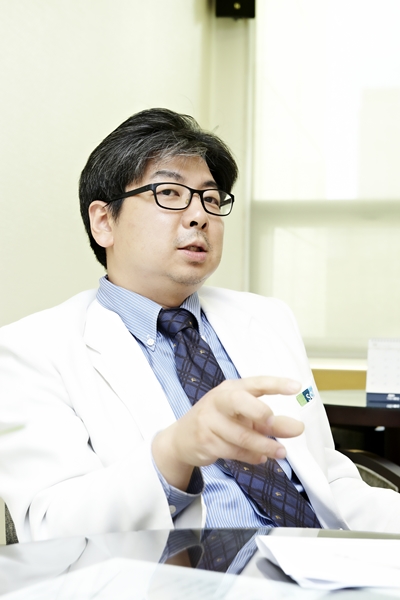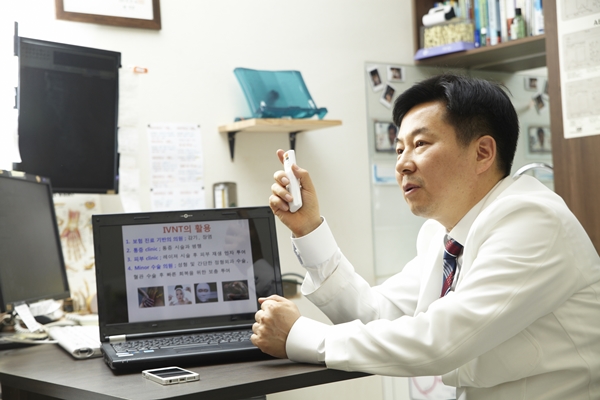Application of the IVNT to aesthetic medicine has brought about alpha-lipoic acid injection, also known as ‘Cinderella injection’, and glutathione injection, nicknamed ‘white jade injection’. The IVNT has recently been recognized for its potential benefit as an aesthetic treatment and became popular among patients and doctors. However, controversy exists over its efficacy due to lack of clinical data. A specialist who uses IVNT frequently shares his experience of applying the intravenous injection to aesthetic medicine.


Dr. Eun-soo Park, Professor of Plastic Surgery, Soonchunhyang University Bucheon Hospital, Dr. Gu-jin Lee of Mediens Clinic

Dr. Jae-hwan Lee of Hyo Sarang Family Medicine
Cost of IVNT
The cost of IVNT widely varies depending on the private practice or hospital. It also changes based on the region, hospital policies as well as type and amount of ingredients used. Dr. Son emphasizes the importance of adhering to the listed price of the drug.
“One should not diverge too far from the listed price. We charge additional KRW 5,000 for each 10g of Vitamin C added in the IV solution. We set the starting price at KRW 20,000 and charge for additional ingredients used. The starting price of licorice injection and placenta injection is KRW 5,000 and that of glutathione injection, alpha-lipoic acid injection and Multi-Blue injection is KRW 50,000. The price of our IV therapies ranges from KRW 25,000 to 300,000. As the price depends on the ingredients used, the patient feels the price to be fair.”
Dr. Gu-jin Lee, on the other hand, thinks that the flexible pricing of IVNF offers an advantage to doctors.
“I charged a lower price for the same injection when I practiced in Hanam-dong. One has to follow market trends. Tacit agreement exists regarding prices differing across affluent and less affluent neighborhoods. The IVNT’s price can range from KRW 30,000 to 1 million. This wide variation can provide an opportunity for doctors who offer special ingredients.”
Dr. Hae-yong Eoh tried differentiating the prices as his practice is one of very few that specialize in IVNT.
“I charge higher prices than other doctors. The average price of the Cocktail injection is around KRW 100,000 to 150,000. However, each patient spends about 2 hours of treatment per visit; 1 hour receiving the IV fluid lying down and 1 hour of consultation. Therefore, the profitability is lower than one would expect.”
[Advertisement] FCR® (Fractional Prickle CoralCalcium Regentron) – Manufacturer: (www.illglobal.com)]
Older and experienced doctors have the advantage
Treatments such as dermal filler or botulinum toxin, etc. have become widely popular but the price has also drastically dropped. The so-called ‘dumping’ in the aesthetic practice has breached the lowest margin level. Most doctors expect that this would also happen with IVNT. Some private practices are already being accused of dumping. Despite these negative predictions, Dr. Son says the IVNT has a bright future.
“The specialist can begin offering IV injections with minimal space and equipment. He can also increase profits only with his knowledge of different ingredients. If the consumer prices were to be lowered, the supplier price will also go down and doctors will not have to absorb the difference. Rather, doctors should focus more on creating more effective concoctions. The most important factor associated with the outcome is the patient’s psychological state. In my practice, skeptical patients tend to experience lower efficacy. The distillate is mixed with nutrients to create the IV solution. If the solution is absorbed easily into blood vessels, the patient urinates immediately after treatment. On the other hand, if the solution does not get absorbed in the blood vessels, it can cause pain during IV infusion. It is very important for patients to feel comfortable during treatment.”
Dr. Jae-hwan Lee also predicts that IVNT will stay competitive in the future due to its unique advantages.
“Other treatments can also offer profitability and medical benefits. However, the IVNT is special in that older doctors can also perform the treatment. Patients tend to prefer younger doctors and older doctors do experience part of their skills deteriorate. However, the biochemical aspect of the IVNT gives more experienced doctors an advantage. So an older age and longer experience will give doctors a competitive edge. I hope more doctors are interested and work together to develop this treatment.”
Placebo effect VS Real efficacy
Controversy over the IVNT continues despite its various benefits and effects. The biggest weakness of the treatment is the lack of scientific evidence. Designing a clinical study is difficult as a key determinant of the efficacy of IVNT is the patient’s feelings. Studies also need to identify whether certain feelings felt by patients are due to placebo effect or the drug. Dr. Eun-soo Park, Professor of Plastic Surgery, Soonchunhyang University Bucheon Hospital, commented on this.
“The IVNT is mainly used as a symptomatic and adjunct treatment except for a few special cases. That is why there is little scientific evidence on this treatment. However, as more people suffer from imbalanced nutrition due to fast paced lifestyles and diet change, the application of IVNT is expected to widen and more studies will be conducted. According to Reduction of Fibromyalgia Symptoms Through IVNT: Results of a Pilot Clinical Trial (Altern Ther Health Med. 2007 May-Jun;13(3):32-4) published 8 years ago, the IVNT reduced pain and fatigue and improved daily life in patients with fibromyalgia-related chronic pain. I think more studies in the future will examine the objective efficacy of the IVNT in various conditions and lead to a wider application of the IVNT.”
Dr. Eoh of Hilac Clinic says “Vitamin C is pretty much the only nutrient with sufficient scientific evidence.”
“One of the reasons for lack of clinical data is that the patents for ingredients such as vitamins and glutathione, etc. have expired and pharmaceutical companies do not need to invest in developing new drugs with these ingredients or fund clinical studies.”
Another problem is that some tout the IVNT as a cure-all. Dermatologists are skeptical of claims of curing psoriasis with one treatment of IVNT. Dr. Jae-hoon Park of Jeonju Arumdaun Dermatology says “I am very skeptical of a claim that psoriasis was cured with the IVNT. The IVNT can be beneficial as an adjunct for atopic dermatitis but is not a sufficient treatment.”
Dr. Eun-soo Park agrees.
“The IVNT rapidly supplies necessary nutrients and thereby normalizes cell functions and bring systemic improvement to a degree, however, more scientific evidence and consensus are needed in the future to use the IVNT as a treatment.”
Most doctors will say that the IVNT improves the general health rather than treat a particular disease. Dr. Eoh shared his opinion.
“Good nutrition is important, particularly for ICU patients. Also, good nutrition and good rest can improve the general health and energy level in a person fatigued from a busy schedule and lack of sleep. When rapid provision of good nutrition is difficult, the IVNT can help. The IVNT is particularly effective when used in the right way in right patients.”
Scientific analysis is being used to make the prescription more accurate and customized for each patient. Genetic analysis and urine organic acid screening, etc. can be used to provide an accurate assessment of the patient’s general health.
Dr. Jae-hwan Lee, who specializes in organic acid screening, explains that urinalysis assesses the health of the intestines and immunity, etc. and help identify the degree of fatigue and skin problems.
“Urine organic acid screening is related to how the human body produces energy. The human body metabolizes carbohydrates, fat and protein ingested as food to produce energy and organic acids are produced as a metabolite. The organic acid screening examines the amount of organic acid of each cycle and identifies the catalyst of the cycle with lower level of organic acid. When the lacking catalysts are identified, they are replenished in the form of IVNT. However, this treatment is not covered by insurance and can be costly for patients. Functional medicine screening currently costs about KRW 300,000 per item.”
The purpose of IVNT is to induce healthy changes in the body by providing needed nutrition based on accurate tests. Dr. Jae-hwan Lee calls this ‘prenatal care for cells.’
“The prenatal care continues for 10 months. The IVNT is similar to that in principle. Each cell in our body has a fixed life cycle. It is 120 days for red blood cells, a week for white blood cells, 5 days for platelets, and 400 days for osteocytes. In our body, there are no cells that are over 2 years old. Liver, kidney and skin cells have the generation cycle of about 2-3 months. If balanced nutrition is provided during this period, healthy cells will be generated. I recommend once weekly IV infusion. This frequency is based on the half life of Vitamin C, glutathione and antioxidants. As the half life is about a week, once weekly provision of nutrients continued for 3 months will bring improvements.”
Despite such beliefs of specialists well-versed in IVNT, controversy over its efficacy seems to be growing along with its popularity. Long-term clinical studies are needed to establish scientific evidence. Only then, the IVNT will be established as a main therapy for both the doctors and patients.
Article/ In-hong Yoo, Yoon-ae Shin Photography/Sang-hee Won, Young-gil Kim
-To be continued-




















